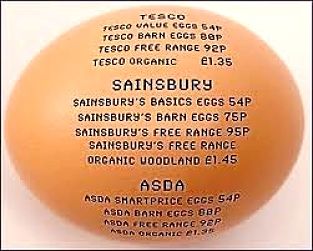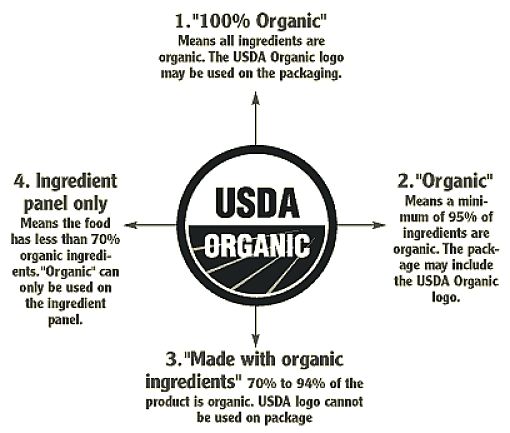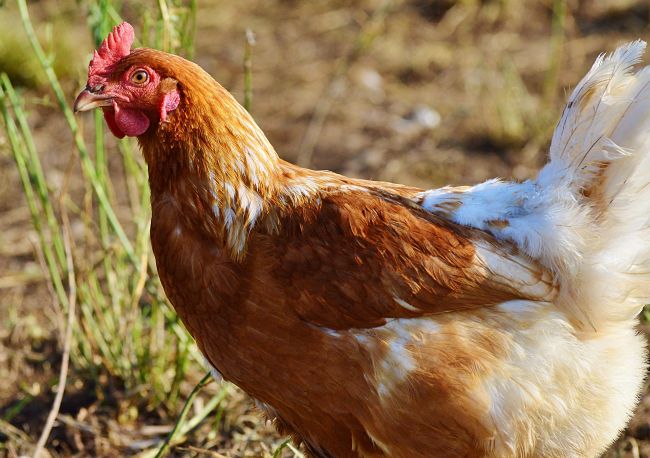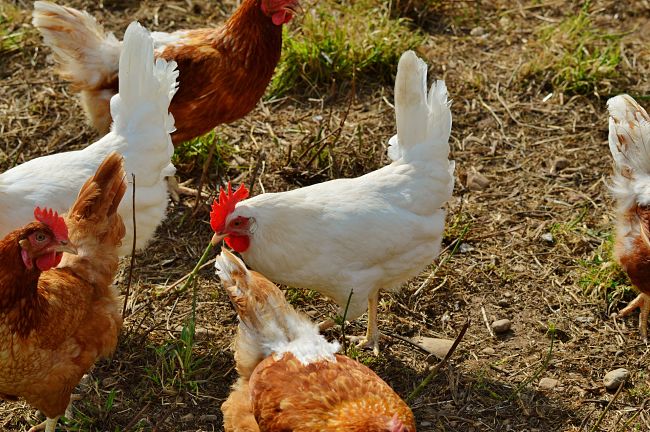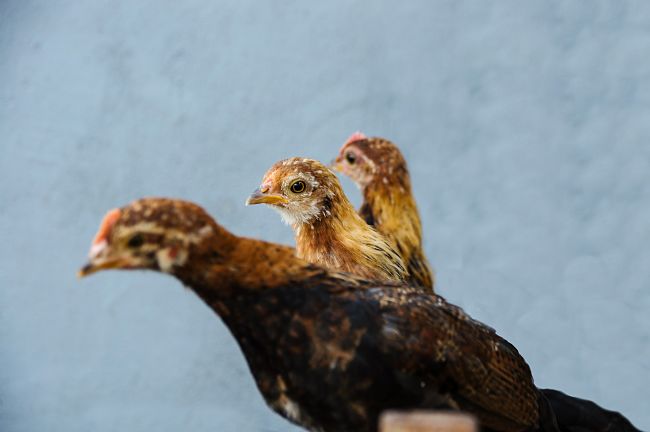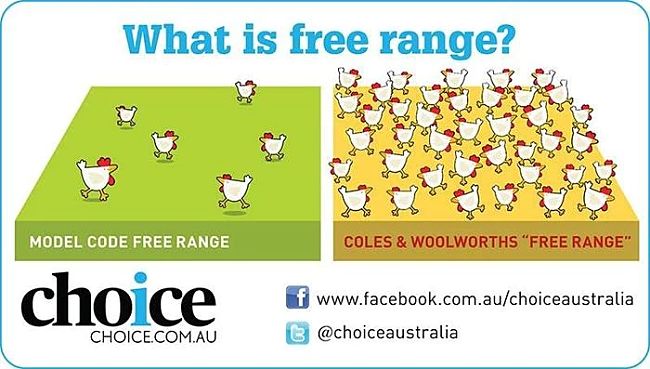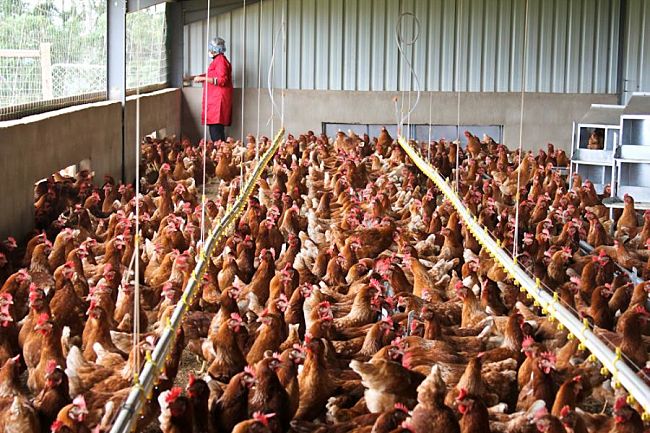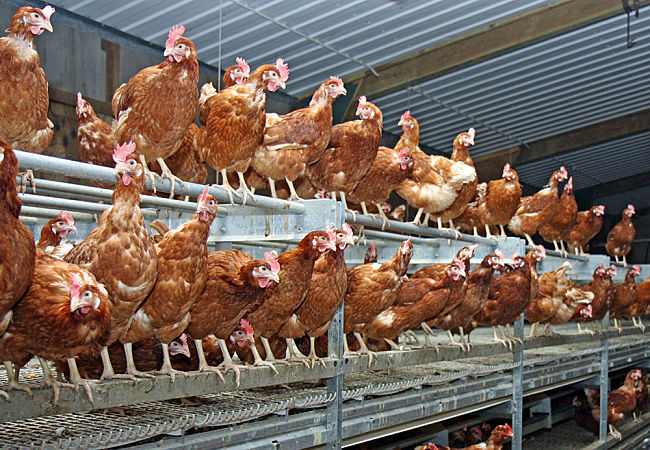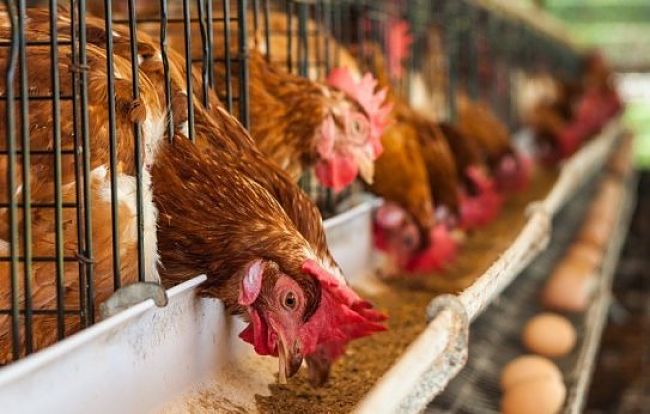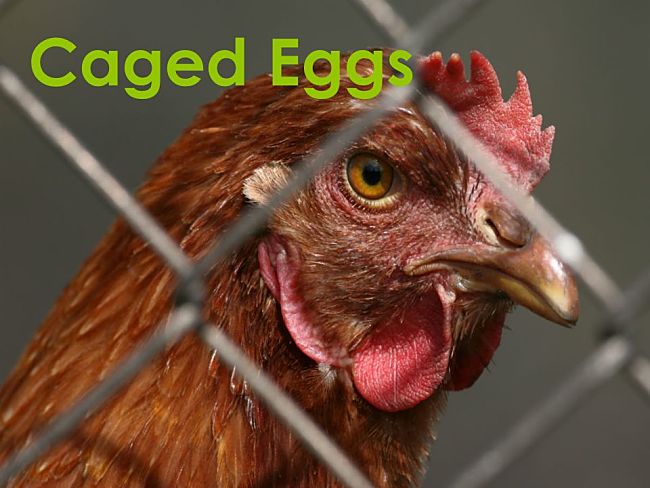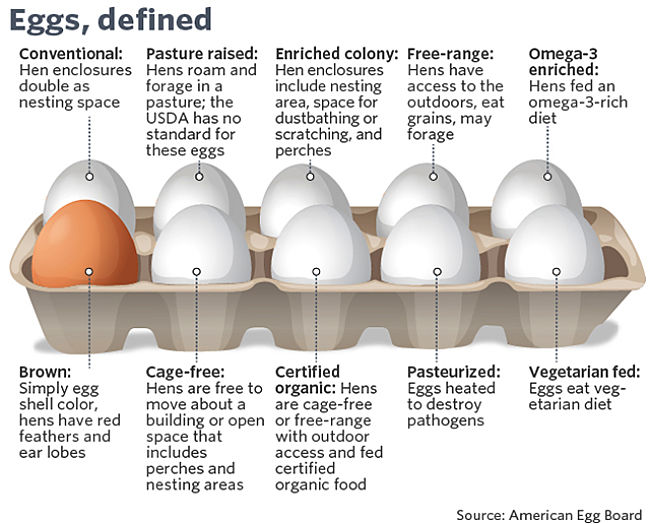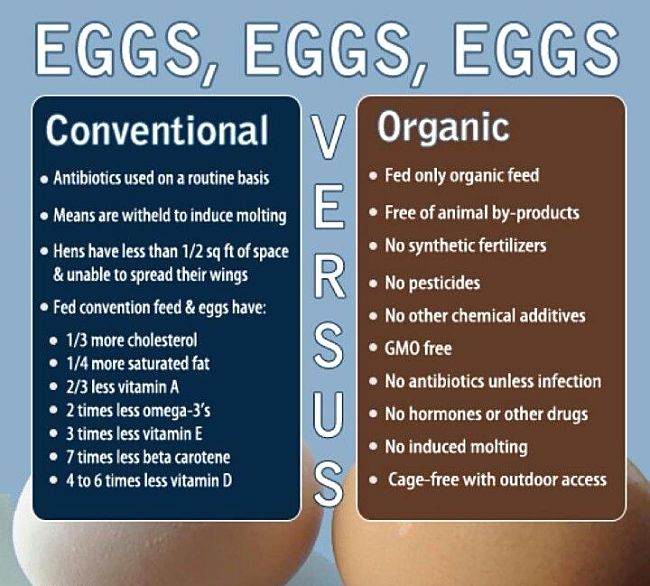Organic Eggs and Poultry are not Free Range, Neither are Free Range Eggs Organic
It is odd that most people believe that organic produce is also free range and vice versa. However free range products are not necessarily organic and organic food is not necessarily free range. Many consumers believe that the regulations should be changed.
Does 'Organic' Mean Animals can Roam Free in Paddocks and Pastures? - NO
The USDA's current regulations on organic foods require that all livestock can spend time outdoors, so the animals can engage in "natural behaviour." However the rules don't define how much time should be allowed, how much space the animals should have, or whether that space should be in a pasture, on a concrete porch or in an enclosure. This is a far cry from wandering on grass and dirt in a paddock or an open field.
While the USDA 'Free Range' rule also specifies the poultry has 'access to the outside' it does not mean that it is organic.
Organic Not Free Range
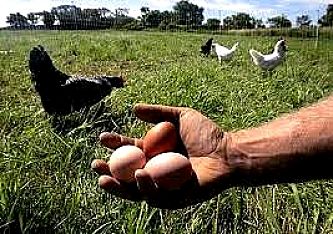
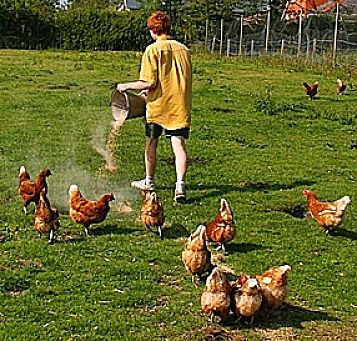
The same issues apply in many other counties where 'organic' does not necessarily mean free range.
On many large organic poultry farms, chickens spend their 'outdoor time' on concrete slabs or other artificial areas in which there's no access to grass or dirt in which the hens and scratch and peck. Many consumer groups have urged the USDA to change the rules so that 'outdoors' means that the chickens are give time to scratch and peck in real pastures.
Critics say those animals may be fed organic feed, but they're being raised in conditions that bear little resemble those on conventional free range farms and fall far short of what most people expect when they buy organic foods.
They say that's not what consumers expect when they buy 'organic' eggs, which often come in misleading packages.
The new USDA chicken labelling rules takes effect in 2012.
Does 'Free Range' Mean that Animals are Reared Organically? - NO !
The term 'Free Range' does not mean that animals are fed feeds which differ from normal commercial cage poultry farms. Likewise the label "Free Roaming" does not imply anything about the feed supplies. This means that free-range and free-roaming hens can be fed identically the same animal-derived byproducts, GMO crop feeds, and all sorts of chemicals and additives as are used in non-organic farms. This is why free-range eggs are generally much cheaper than organic eggs.
There are also variations on exactly what is meant by 'free range'. Critics of the stringent EU free-range regulations highlight that commercial free-range egg farming in the EU allows 'Yarding' rather than true Free Range conditions. Yarding simply means that a high-density poultry shed has a fenced yard attached, that is not a pasture or field, but is simply a yard. Yarding provisions are much closer to high-density factory confinement than true Free Range conditions.
Does the word 'Organic' on something, mean that everything in the product is actually organically grown? - NO !
In the US for example, products with only 95% organic ingredients can use the word "organic", and can display the official USDA organic seal. However a third category exists that contains only a minimum of 70% organic ingredients. Food can be labelled "made with organic ingredients", which can mislead many consumers. There are also a wide range of elements and regulations that apply to the definition of 'Organic' throughout the world.
The Definition of Free Range and Organic - Varies greatly between Counties
USA
Free Range - The U.S. Department of Agriculture has very minimal standards, and allows egg producers to freely label any egg as a free-range egg.
"FREE RANGE or FREE ROAMING:
Producers must demonstrate to the Agency that the poultry has been allowed access to the outside."
The definition of 'outside', though, is shaky; does that mean there’s a window chickens could theoretically, but not actually squeeze through? Do the birds actually need to go through it? And 'outside' could be a concrete 'exercise yard, or it could be a fenced and grassed field or pasture. Some producers include a fenced-in section of open concrete in their grow-out houses, with enough room for only 5 % of the thousands of chickens to use it, and this may technically satisfy the term.
The USDA regulations do not specify the quality or size of the outside range nor the duration of time an animal must have access to the outside.
Many producers will label their eggs as 'cage-free' in addition to, or instead of free-range. The standards are currently being reviewed and terms like “pasture raised”and “free roaming” are being considered.
Ranching - In ranching, free-range livestock are permitted to roam without being fenced in, as opposed to fenced-in pastures.
Barn Raised - Recently, US egg labels have started to include the term "barn-roaming". This more accurately describes facilities where the chickens who do not range freely but are allowed access to a barn rather than being confined in cages or pens.
UK
Cage-free - production of eggs in the UK includes barn-raised, free-range and various organic systems. Free-range is the most popular of the non-cage alternatives, accounting for around 30% of all eggs, compared to about 5% in barns and 6% organic. The housing conditions in free-range systems have similar standards to a barn or aviary. In addition, the animals must have constant daytime access to an outside space with vegetation.
Non-cage systems may be single or multi-tier (up to 4 levels), and can have outdoor access or not. Indoor non-cage systems are also referred to as aviaries (for systems with multiple tiers) or barn systems.
Free Range - In the UK, the Department for Environment, Food and Rural Affairs requires that a free range chicken should have access during daylight hours to open-air runs during at least half of their life. Unlike in the United States, this definition also applies to eggs.
Some free range farming in the UK, which accounts for about 25% of production, has also come under criticism regarding animal welfare. Some large scale free range farms have problems with social abnormalities caused by having very large numbers of birds in a restricted outdoor space. Beak trimming to control cannibalism and infighting is common. The animals are vulnerable to predators and diseases.
EU
Free Range - In the European Union the definition is more stringent.
Except for restrictions put in place by a veterinarian in the case of illness, hens must have continuous daytime access to open air runs. The run space must be purposed solely for the hens except for use as orchards, livestock grazing or woodlands. If using the run space for one of these dual purposes, authorization must be obtained by the proper authorities. In free-range
broiler systems, the chickens are given continuous access to an outdoor range during the daytime and sheds are provided where they are housed at night.
The EU regulated marketing standards for egg farmers which specifies the following (cumulative) minimum conditions for the free-range method:
- hens must have continuous daytime access to open-air runs, except in the case of temporary restrictions imposed by veterinary authorities,
- the open-air runs to which hens have access is mainly covered with vegetation and not used for other purposes except for orchards, woodland and livestock grazing if the latter is authorised by the competent authorities,
- the open-air runs must at least satisfy the conditions specified in Article 4 (1)(3)(b)(ii) of Directive 1999/74/EC whereby the maximum stocking density is not greater than 2500 hens per hectare of ground available to the hens or one hen per 4 square metres at all times and the runs are not extending beyond a radius of 150 m from the nearest pop-hole of the building; an extension of up to 350 m from the nearest pop-hole of the building is permissible provided that a sufficient number of shelters and drinking troughs within the meaning of that provision are evenly distributed throughout the whole open-air run with at least four shelters per hectare.
Egg farming in EU is classified into 4 categories:
- Organic (ecological),
- Free Range,
- Barn, and
- Cages.
The mandatory labelling on the egg shells attributes a number (which is the first digit on the label) to each of these categories: 0 for Organic, 1 for Free Range, 2 for Barn and 3 for Cages.
Australia
There are no legal guidelines of definitions of "Free Range" in Australian legislation. So long as the birds have got some range outside during each day their eggs can be labelled as Free Range. The lack of a legal definition of "free range" is at the heart of what has been claimed are widespread substitution problems. However there are voluntary codes and certifications available by one of the endorsing and auditing 'free-range' organisations.
The free-range industry in Australia is self-regulated and there is no compulsory national accreditation system. It is basically up to individual producers to decide whether they want their eggs certified by either an animal welfare organisation, a state-based free-range egg association or the newly formed national body, the Free-Range Egg and Poultry Association of Australia.
While there isn't a legal definition of "free range", there are general guidelines for producers outlined in the code of practice for the welfare of animals that was agreed to by industry, animal welfare groups (such as the RSPCA) and governments.
The code states that:
- Hens should not be housed on land which is contaminated with chemicals, poisonous plants or organisms which cause or carry disease that could threaten the hens' health.
- The birds must be protected from predators at all times and must have access to shaded areas and shelter from rain, as well as wind breaks.
- All birds must be able to range outside for eight hours a day. The only exception to this is in adverse weather conditions or serious outbreaks of disease, when the birds may be kept inside.
But many producers believe the guidelines are not tough enough.
The advantage of getting the RSPCA's label of approval is that people tend to be drawn towards the eggs that have our logo on because they recognise the RSPCA has high standards, and they know that if they are buying eggs with our logo on, that they do comply with a set of standards that are regularly inspected to make sure those farms are doing things properly.
The Australian Egg Corporation has started its own national scheme called Egg Corp. It is a quality assurance program that checks egg labelling, animal health and welfare, food safety and biosecurity of all types of eggs on the market. But, again, it is a voluntary system.
Free-range egg production in Australia has been steadily increasing in volume, value and market share over the past decade. They make up 15% of the domestic market and are worth about 25% of the value of the Australian egg industry, which is more than $70 million a year. A dozen free-range eggs can cost twice that of caged eggs, but more people are prepared to pay for the premium egg on the market. However more producers are prepared to rort the system to make an easy profit and there are claims that half the free-range eggs sold in Australia are not the real deal.
Deane Modra was one of first free-range egg producer in Australia to be accredited by the RSPCA. The hens at this farm on Kanagroo Island are kept indoors at night where they lay 99% of their eggs and are debeaked to prevent cannibalism. His farm is inspected every 12 weeks by RSPCA officials and has to pay 2% of his annual income for the privilege, around $160 a week.
This farm has some very special characteristics in that the birds have an awful lot of space outside, but the key aspect of that space is that there is a lot of ground coverage. So those birds are able to move into the shade if it's sunny. They've got protection from aerial predators, which is a key issue. There is no problem with overforaging or overgrazing of the free-range areas. There are no foxes on Kangaroo Island, which is a definite benefit, because predator control is important.
So a free-range egg in Australia can be many things. It can come from a hen that is debeaked, let to roam completely free, kept inside overnight from predators. It can come from a farm inspected by authorities once a year, every couple of monthsor not at all.
It seems as long as there is no legal definition of "free range", the claims will continue and confusion in the marketplace will remain.
A new study by the consumer advocate, Choice magazine, has found that free-range eggs are often not as fresh as the should be. It says up to 40 % of free range eggs they tested fail the freshness test, and that the definition of free range unclear and needs to be clarified. They found that over half the hens described as free-range were housed in huge sheds, where they never go outside and their eggs come off conveyor belts.
While the European Union has enforceable standards, in Australia there are only voluntary standards set by the Free Range Egg and Poultry Association of Australia (FREPAA), Biological Farmers of Australia and animal welfare groups, including the RSPCA.
Independent Checking of Free Range Status
British and Australian scientists recently developed a way to test eggs to see if they have been substituted without having to inspect farms. The dust accumulated on the surface of the egg is the focus of the test under ultraviolet lights. Freshly laid eggs are moist and dust attaches to the shell. The pattern on the shell's surface varies according to the type of egg, whether it has been laid on cage floors, in barn nest boxes or outdoors. But the method has not been embraced in Australia and there are doubters.
UPDATE April 2017
The five-year wait for a national standard on free-range eggs stocking density in Australia is over with the Federal Government announcing new laws.
Any eggs labelled "free range" will require a stocking density outdoors of 10,000 hens or fewer per hectare.
Under the laws, the stocking density has to be prominently displayed on the packaging and the hens must have meaningful and regular access to the outdoors.
But consumer group Choice said it was disappointed with the new standards and vowed to maintain its recommendation to "boycott" densely stocked farmed eggs at the supermarkets.
Egg farmers have said they could now invest in their egg business again, with certainty about stocking density of hens outdoors.
So what does 10,000 birds per hectare look like?
"For people looking for a shorthand way of understanding, it's four chooks on the back of a ute, or four chooks on a double bed, or one per square metre," said John Dunn of Egg Farmers of Australia.
"They won't all be outside at the same time, and they mostly flock together.
"Any farm, stocked at the maximum, will have plenty of room to move."
Choice says new standards are disappointing
Choice has complained in the past that when the birds waited inside, it was as packed as a "rock concert mosh pit".
Egg farmers said this was not about indoor stocking densities and that will be decided in the poultry welfare standards and guidelines.
There has never been a national free-range stocking density standard, and this has taken ministers and the Federal Government almost five years to introduce.
Choice has gained a lot of traction in that space, with a phone App, CluckAR.
Using it to scan the egg carton, it will come up with a quick rating and the stocking density, of between 1,000 birds to 10,000 birds per hectare.
Organic Certification throughout the World
Organic certification requirements vary from country to country, and generally involve a set of production standards for storage, growing, processing, packaging and shipping that include:
- avoidance of most synthetic chemical inputs (e.g. fertilizers, pesticides, antibiotics, food additives, etc., genetically modified organisms, irradiation, and the use of sewage sludge;
- use of farmland that has been free from synthetic chemicals for a number of years (usually at least 3 years);
- Keeping detailed written production and sales records (audit trail);
- maintaining strict physical separation of organic products from non-certified products;
- undergoing periodic on-site inspections.
- In some countries, certification is overseen by the Government, and commercial use of the term organic is legally restricted.
The United States, the European Union, Canada and Japan have comprehensive organic legislation, and the term "organic" may be used only by certified producers.
In countries without organic laws, government guidelines may or may not exist, and certification is handled by non-profit organizations and private companies.
So Buyer Beware!
Some things to consider when buying food and products:
- 'Natural' does not mean the product is organic or healthy
- 'Free-range' does not mean organic and the freedom may be restricted to a barn or concrete 'exercise' yard
- 'Hormone-free' does not mean the product is organic
- 'Organic' does not mean that all ingredients and feeds are actually organically grown
- 'Cage-free' doesn't mean that the chickens were free to peck around in the fresh air or mean that the chickens went outdoors.
Related Articles
=> Vegan Egg Substitutes for Baking, Cooking - Best Egg Replacements - Guide and Tips
=> 10 Facts About Eggs - Myths Cracked
=> Health Benefits Eggplants and Aubergine - Nutrition Facts, Uses and Best Ever Recipes
=> Health Benefits Eggplants, Aubergine Nutrition Facts, Best Recipes
=>Raising Chickens for Eggs, Meat, Gardens, Plus Showing, Family Fun, Education
=> Homemade Chinese Egg Rolls - Recipes, Tips and Variations
=> Best Scrambled Eggs Recipes - Tips for Perfect Timing and Fabulous Flavors
=> Chickpea Water Aquafaba Recipes - Vegan Egg-White Alternative
=> How To Make Panades from Leftovers, and Best Egg Strata Recipes
=> Grilled Smoky Eggplant Yogurt Dip Recipe
